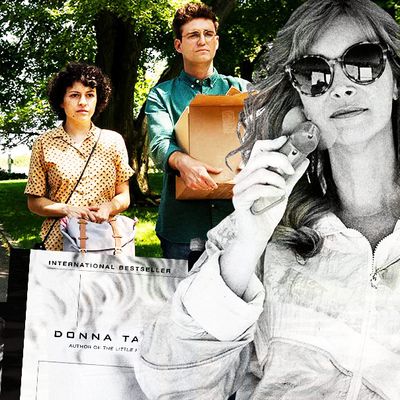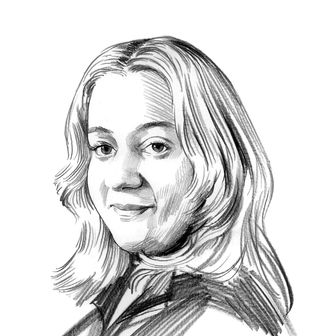
With a modern take on the whodunit narrative twisted through a sardonically Bushwick sense of humor, Search Party’s first season was one of the most enjoyable TV debuts in recent memory. Just when we thought co-creators Sarah-Violet Bliss, Charles Rogers, and Michael Showalter couldn’t outdo themselves — accidental murder in Canada, anyone? — the show is better than ever in season two, switching its narrative to the slowly unfurling aftermath of covering up an innocent man’s death. Will Dory, Drew, Elliott, and Portia get caught? Will they head to jail? Ahead of Sunday’s finale, Vulture called up Bliss and Rogers to discuss the key influences that shaped Search Party as we know it.
Woody Allen
“I don’t want to say Woody Allen, and yet it’s unavoidable. For the first season, Manhattan Murder Mystery was a huge influence for us in terms of mystery and comedy. Even just the characters having dissatisfaction in their life and wanting more excitement. That was a huge movie that we talked about a lot for the pilot.” —Bliss
The Secret History by Donna Tartt
“Not in terms of the style that we wanted, but plot-wise and how things moved forward.” —Bliss
Alfred Hitchcock
“Tone and style, Hitchcock was definitely the thing we wanted to lean into the most. We talked a lot with our director about that. It manifested itself the most in production design and camera work. There’s a lot of mirrors. The fragmented mirror is a big concluding symbol of the second season, it’s a big symbol. Reflections and prisms were used a lot. In episode eight, we have a full homage to Vertigo in a nightmare sequence with Dory. And with the score, as well.” —Rogers
Roman Polanski
“He was a very big influence for repulsion and Dory’s state of mind, which coincided with her hyperdramatic, panicked life. It was a clear homage to Polanski.” —Rogers
Agatha Christie
“In my junior-high, we had this program where you got ‘reading points’ for reading a certain amount of books. Everyone had to do it. Our teacher was this crazy chain-smoker who would smoke outside of the window and drink Diet Doctor Peppers all day. And she was obsessed with Agatha Christie. She would give us double or triple ‘reading points’ for reading Agatha Christie. So our entire junior-high consumed Agatha Christie like there was no tomorrow. It was all anyone read that entire year. I ended up reading ten of her books, at least. I love a cast of characters where everyone’s got intrigue and mystery. And everyone’s created so distinctly from one another. That was part of the first season, the feeling of not knowing what was up with Chantal. You would theorize everything about her disappearance. There was something so involving about that type of literature.” —Rogers
Dateline
“I love Dateline. It obviously isn’t a direct influence, but it’s structured around talking about people’s obsessions of true crime. We also brought up Serial and Law & Order in that regard as well. Those sorts of stories. Weirdly enough, we draw a lot of influences from shows that aren’t too much like our shows. They come up when we’re trying to pitch ideas, even though they’re not in the same world as our show.” —Bliss
Silence of the Lambs
“There’s a moment in one of the episodes this season where Dory and Joy, the investigator, lock eyes. It’s very tense, and we took that from the moment shared between Clarice Starling and Hannibal Lecter. It was a really cool and simple way to add tension. This season was about co-opting a visual style that’s a part of the language of thrillers.” —Rogers
The Comeback
“When we think about Portia’s story line, the world of actors is so tired in television and film. The Comeback did it better than any show has ever done. How do we have a story line for Portia that doesn’t feel like it was already mastered? We thought about that a lot.” —Rogers
The Magnetic Fields
“We spent a lot of time with the final song this season. We had a couple of bands do a cover of ‘Epitaph to My Heart.’ We had talked about the band in season one, if we wanted any musicians to cover a certain song. The Magnetic Fields came up, and we got it to finally happen in season two. The lyrics work for what we were doing. The music in the show is more moody and atmospheric, taking you to an elevated place.” —Bliss
Robert C. Wiles, “The Most Beautiful Suicide”
“There’s a Life magazine photograph of a woman who jumps off a building to kill herself and landed on a car. It’s an iconic picture. It’s in the background of the scenes where John Early’s character go to his publishing house, in his editor’s office. That was an image I found to be striking and dramatic.” —Rogers
Wassily Kandinsky
“When Portia’s in a play in episode eight, which is a Charles Manson–themed play, it has a very Kandinsky abstract expressionist vibe. In both season one and two, in fact, there’s a lot of German expressionism of hard shadows and very graphic geometric visuals. Things that involve balance and make you feel unsettled. That’s at the heart of the show’s sense of design.” —Rogers
The femme fatale
“The idea, especially for Dory, was present.” —Bliss
Life in general
“We very much draw in life to make this show, especially with people that we know. The biggest Search Party reference involves friends as opposed to literature. We’re always texting and communicating about people who we love who are maybe a little bit crazy. Because everyone is. The way people present themselves on social media, the things people pride themselves on, and the way people identify are the forefronts of the themes of the show. So our greatest references are us.” —Rogers


